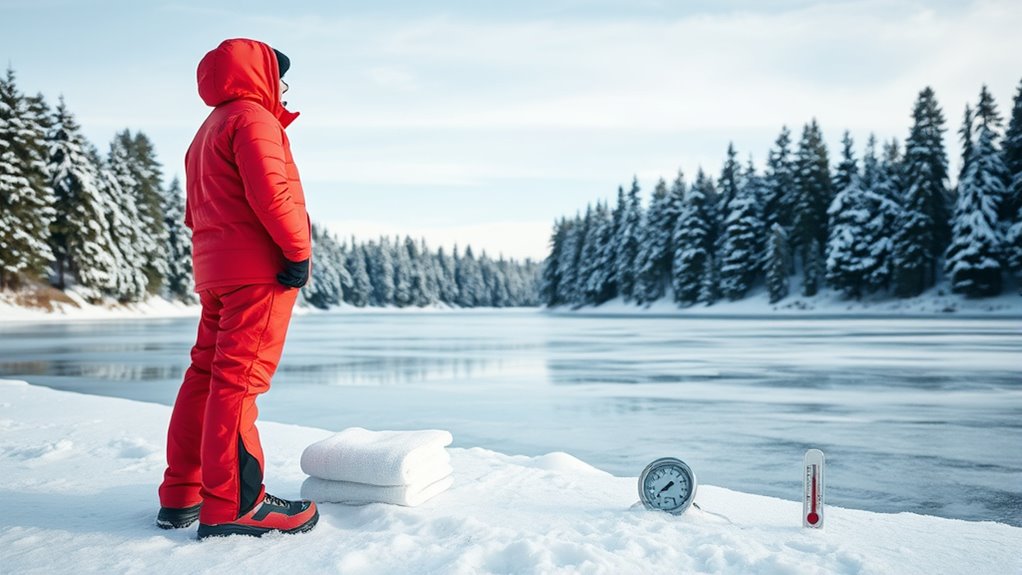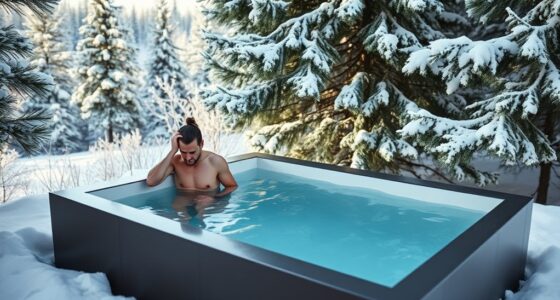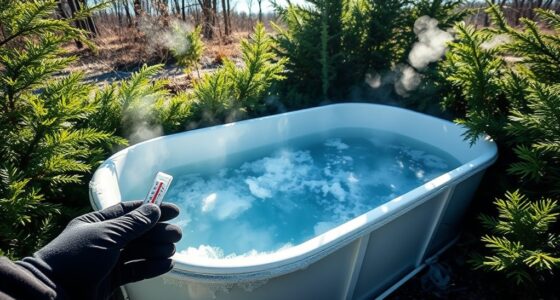Many beginners believe they must start with extreme cold or do daily cold showers, but rushing can cause injury or burnout. Longer exposure isn’t always better, and gradual progress is key. Overlooking signs of overexposure or hypothermia can be dangerous. Proper warm-up, breathing, and mindset matter just as much as the cold itself. Most myths involve thinking cold exposure is only for athletes or expecting instant results. Keep exploring to uncover practical tips that set you up for success.
Key Takeaways
- Immediate immersion in extreme cold without warm-up increases risk; gradual adaptation and proper warm-up are essential.
- Longer cold exposure isn’t always better; focus on consistency and gradual increases to build resilience safely.
- Daily cold showers are not necessary; listen to your body and avoid overexposure to prevent hypothermia.
- Recognizing early signs of overexposure, like shivering and confusion, is crucial to prevent dangerous situations.
- Cold exposure is suitable for everyone; proper warm-up and gradual protocols make it safe regardless of fitness level.
Believing You Need to Start With Extreme Cold Right Away

Many beginners believe they need to jump straight into freezing temperatures to see benefits, but this isn’t necessary. Starting with extreme cold can overwhelm your body and hinder your progress. Instead, focus on gradual cold adaptation, allowing your body to adjust over time. This approach helps build mental resilience as you learn to manage discomfort without pushing too hard too soon. When you ease into cold exposure, you give your nervous system time to adapt, reducing stress and increasing your confidence. Remember, safety precautions are essential to prevent injury or adverse reactions. You don’t need to endure icy waters right away; small, manageable exposures build the foundation for stronger mental resilience and better physical adaptation. Patience and gradual progression will serve you far better than rushing into extreme cold.
Assuming Longer Cold Exposure Is Always Better
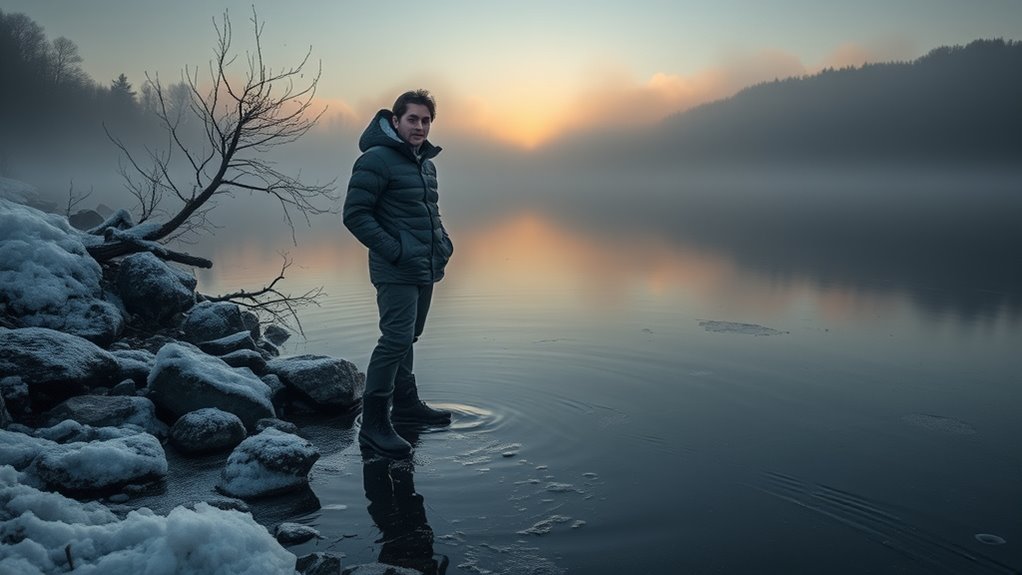
While it might seem logical that longer cold exposures yield greater benefits, this isn’t always the case. Pushing yourself too far or too long too quickly can hinder your progress and pose safety risks. Instead, focus on gradual adaptation—gradually increasing exposure time allows your body to build resilience safely. Rushing into extended cold sessions can cause discomfort, hypothermia, or other health issues, especially if your body isn’t prepared. Always prioritize safety precautions, such as listening to your body and avoiding extreme cold if you feel unwell. Remember, cold exposure protocols and patience matter more than duration. Short, frequent exposures with proper progression are more effective and safer than attempting to do long sessions from the start.
Thinking You Must Do Cold Showers Every Day

Thinking you need to take cold showers every day can lead to unnecessary stress and burnout. It’s tempting to believe daily exposure is essential, but mental preparation plays a key role in managing expectations and avoiding frustration. Rushing into daily cold showers without considering environmental factors like room temperature or your current health can make the experience more uncomfortable than beneficial. Instead, focus on listening to your body and adjusting frequency based on how you feel. Quality matters more than quantity; a few well-planned sessions each week can be more effective and sustainable than daily immersion. Remember, consistency is important, but forcing daily cold exposure can undermine your progress and mental well-being. Prioritize gradual adaptation and mental readiness over rigid schedules. Incorporating a mindful approach to cold exposure aligns with the benefits of yoga, supporting overall mental resilience and physical recovery.
Overlooking the Importance of Gradual Progression
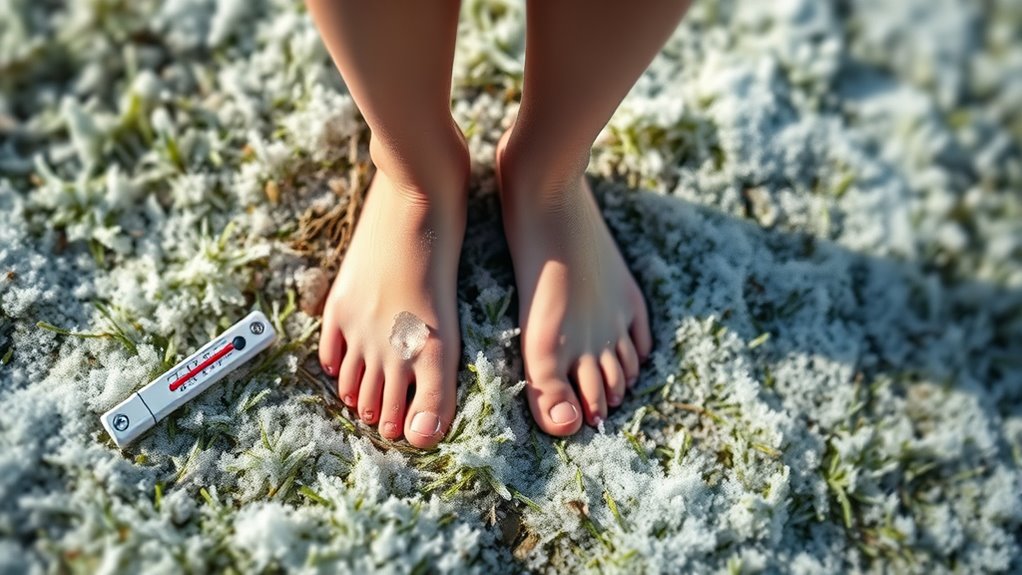
Jumping into cold exposure too quickly can lead to overdoing it and potential setbacks. Building your tolerance gradually helps you avoid sudden shocks and reduces the risk of injury. Take small steps to guarantee safe progress and long-term benefits. Incorporating gradual progression into your routine can also improve your overall experience and effectiveness.
Risk of Overdoing It
One common mistake beginners make is rushing into cold exposure without gradually building up tolerance. This can lead to severe cold shock, which overwhelms your body and increases the risk of hypothermia or injury. Overdoing it also hampers your mental resilience, making it harder to stay calm and focused during future exposures. Pushing too hard too soon can cause panic or panic-like reactions, undermining your progress. Instead, you should listen to your body and increase exposure time or cold intensity slowly. This cautious approach helps your system adapt safely and strengthens your mental resilience over time. Remember, consistency beats intensity—building your tolerance gradually is key to avoiding setbacks and enjoying the long-term benefits of cold exposure. Incorporating proper sleep hygiene and recovery strategies can further enhance your resilience and overall well-being.
Building Tolerance Safely
Building tolerance safely means recognizing that progress in cold exposure doesn’t happen overnight. You need to focus on gradual progression to allow your body to adapt physically and mentally. This steady approach fosters physiological adaptation, helping your body respond better to cold over time. As you expose yourself in small, manageable steps, you build mental resilience, which is essential for handling colder temperatures confidently. Rushing into intense cold exposure can lead to discomfort or even injury, but a patient, incremental strategy ensures safer, sustainable improvements. Remember, patience is key; your body needs time to adjust. Continuous monitoring of your response and adherence to safe practices helps mitigate risks associated with cold exposure. Consistent, gradual exposure helps you develop a stronger mind and body, making cold tolerance an achievable goal without risking setbacks.
Avoiding Sudden Shocks
Skipping the gradual progression can lead to shocking your system with sudden cold exposure, which often results in discomfort, injury, or panic. To prevent this, focus on shock management by easing into colder temperatures gradually. Rapid exposure doesn’t give your body time to adapt, making it harder to build tolerance safely. Instead, prioritize gradual adaptation, slowly increasing exposure time or decreasing water temperature over days or weeks. This approach helps your body develop resilience without overwhelming your nervous system. Remember, sudden shocks can trigger intense reactions, so patience is key. By respecting your body’s limits and progressing gradually, you reduce risks and promote long-term tolerance. Additionally, incorporating well-being tips can support your overall readiness for cold exposure. Avoid rushing—your system needs time to adapt to cold, not shock.
Misunderstanding the Signs of Overexposure or Hypothermia
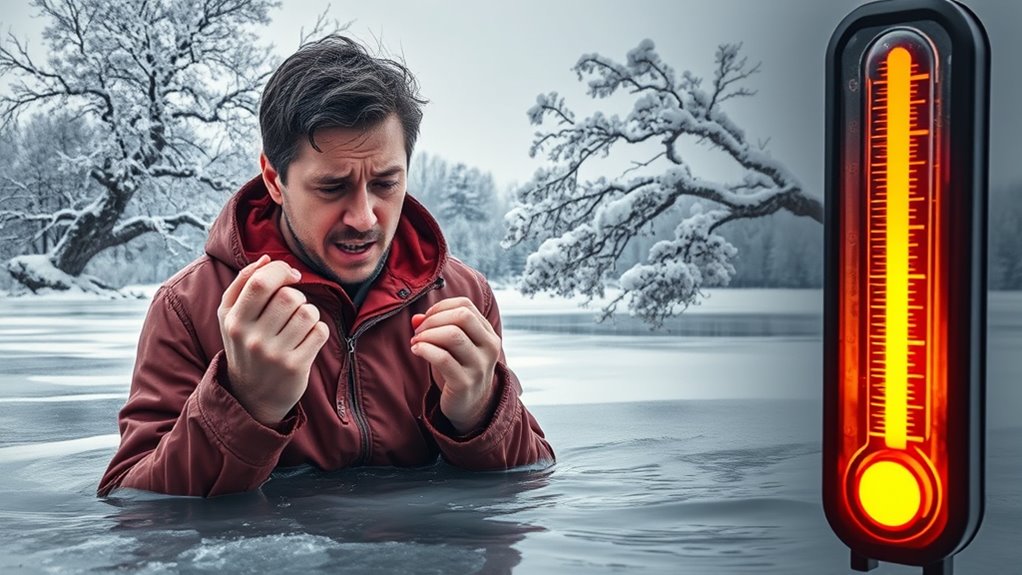
You might not recognize the early signs of mild hypothermia, like shivering or confusion, which can be easy to overlook. If you ignore these symptoms, overexposure can quickly become dangerous. Learning to identify these warning signals helps you stay safe during cold exposure. Regular monitoring of your air quality indicators can also help detect environmental factors that contribute to cold-related risks.
Signs of Mild Hypothermia
Recognizing the signs of mild hypothermia can be tricky because early symptoms often resemble normal cold discomfort or fatigue. Many fall for cold water myths that downplay initial warning signs, risking further exposure. To improve hypothermia awareness, watch for:
- Shivering that’s intense but begins to decrease as hypothermia worsens
- Mild confusion or difficulty focusing
- Clumsiness or lack of coordination
These signs can seem harmless initially, but ignoring them could lead to more serious issues. Keep in mind that mild hypothermia might not always present with obvious symptoms, so stay vigilant. Understanding these early signs helps prevent progression, especially when exposed to cold water or environments, emphasizing the importance of recognizing hypothermia before it worsens. Being aware of the early warning signs is crucial for timely intervention and safety.
Recognizing Overexposure Symptoms
Understanding overexposure symptoms can be challenging because they often mirror signs of mild hypothermia or cold fatigue, leading to misinterpretation. As you progress with cold adaptation, your body may show subtle signals of overexposure, such as shivering, numbness, or fatigue, which can be mistaken for normal responses. Recognizing these early symptoms is crucial for maintaining safety awareness and preventing serious issues. Overexposure can develop quickly if you ignore warning signs, so it’s essential to listen to your body and adjust exposure times accordingly. Knowing how to identify true overexposure helps you stay within safe limits, build resilience gradually, and avoid dangerous consequences. Being vigilant about these symptoms ensures your cold exposure journey remains safe and effective. Proper monitoring is key to safely advancing your adaptation process.
Ignoring the Role of Breathing Techniques and Mindset
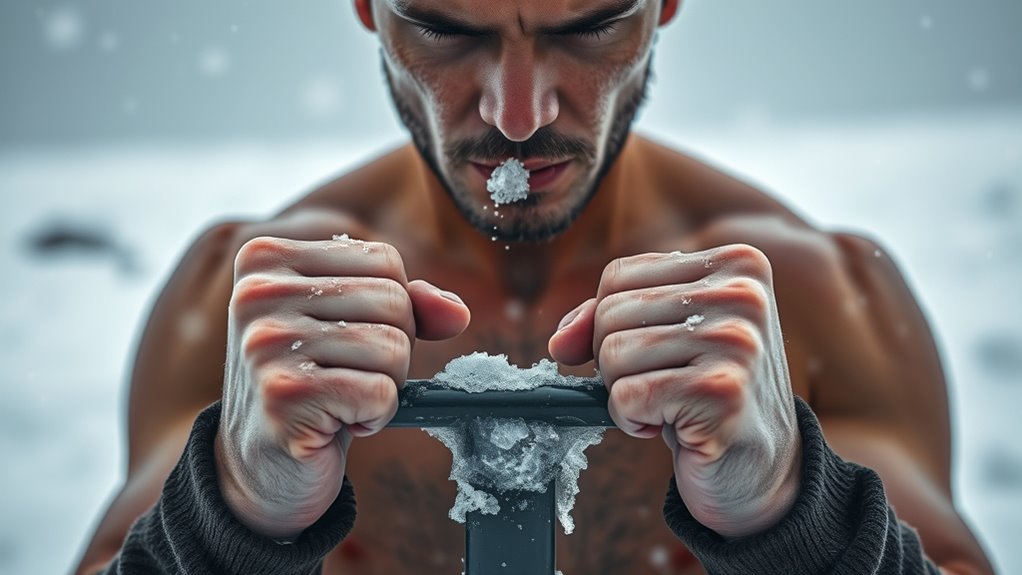
Ignoring the importance of breathing techniques and mindset can considerably undermine the effectiveness of cold exposure practices. Your breathing techniques and mindset training are vital for controlling your body’s response. Without proper focus, you might:
Neglecting breathing and mindset diminishes cold exposure benefits and safety.
- Fail to manage your panic response during cold exposure.
- Miss out on maximizing the benefits of relaxation and mental resilience.
- Struggle to maintain consistency and stay motivated.
Breathing techniques help regulate your heart rate and reduce stress, while a positive mindset keeps you committed to your routine. Developing these skills enhances your ability to stay calm and adapt to the cold, making the experience safer and more effective. Don’t overlook how integral mindset training and mindful breathing are to successful cold exposure.
Believing Cold Exposure Is Only for Athletes or Superfit Individuals
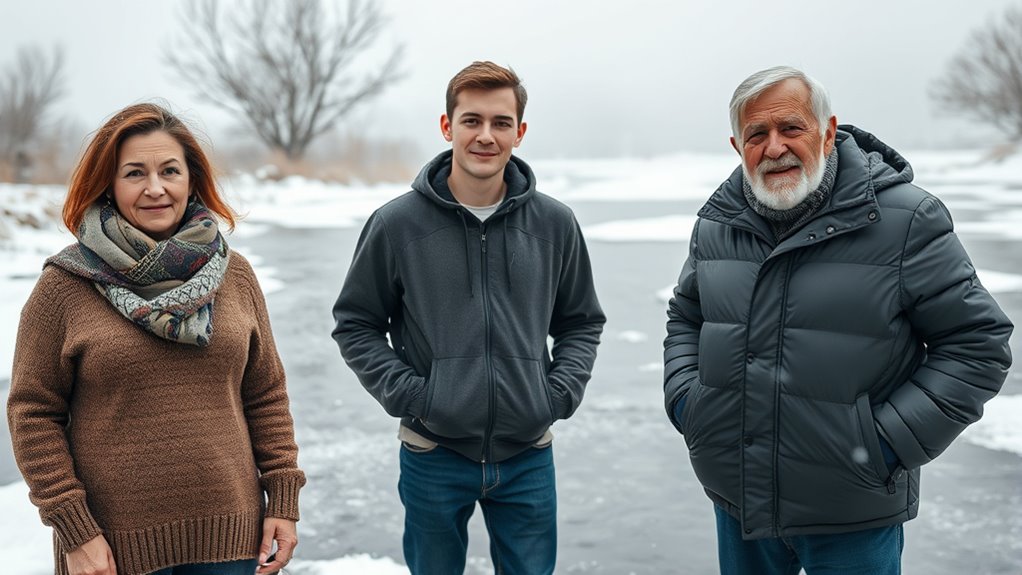
Many people assume that cold exposure is only suitable for athletes or those already in peak physical condition. This belief is one of the common cold exposure myths that fuels beginner misconceptions. You might think you need intense training or a high fitness level to benefit, but that’s not true. Cold exposure can be safe and effective for everyone, regardless of age or fitness. Starting slow and listening to your body is key. The idea that only superfit individuals can handle cold is a misconception that discourages many from trying. In reality, beginner protocols are designed to gradually build resilience, making cold exposure accessible and beneficial for all. Don’t let these myths stop you from experiencing its health-supporting benefits.
Underestimating the Need for Proper Warm-Up Beforehand
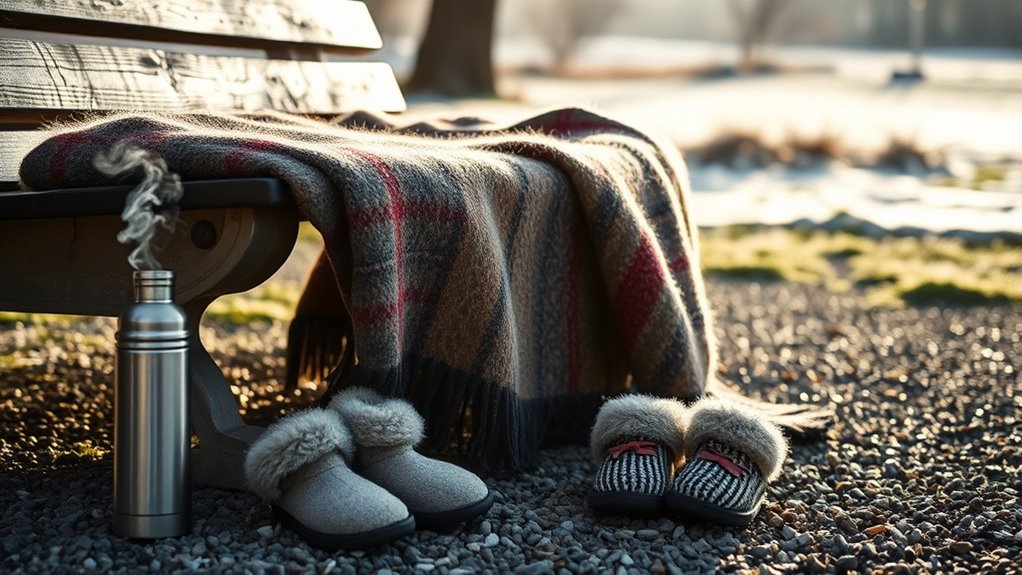
Even if you’re enthusiastic to start cold exposure sessions, skipping a proper warm-up can increase your risk of discomfort or injury. Warming up prepares your body to handle the cold safely. Focus on these key steps:
- Perform warm up exercises that increase blood flow and elevate your core temperature.
- Wear clothing insulation like layered clothing or thermal gear to retain body heat.
- Gradually decrease your body temperature instead of plunging straight into cold exposure.
Neglecting these steps can lead to shock, muscle strains, or hypothermia. A well-planned warm-up ensures your muscles and blood vessels are ready, reducing your risk of adverse effects. Proper preparation makes cold exposure safer and more effective, especially for beginners.
Expecting Immediate Results and Ignoring Consistency
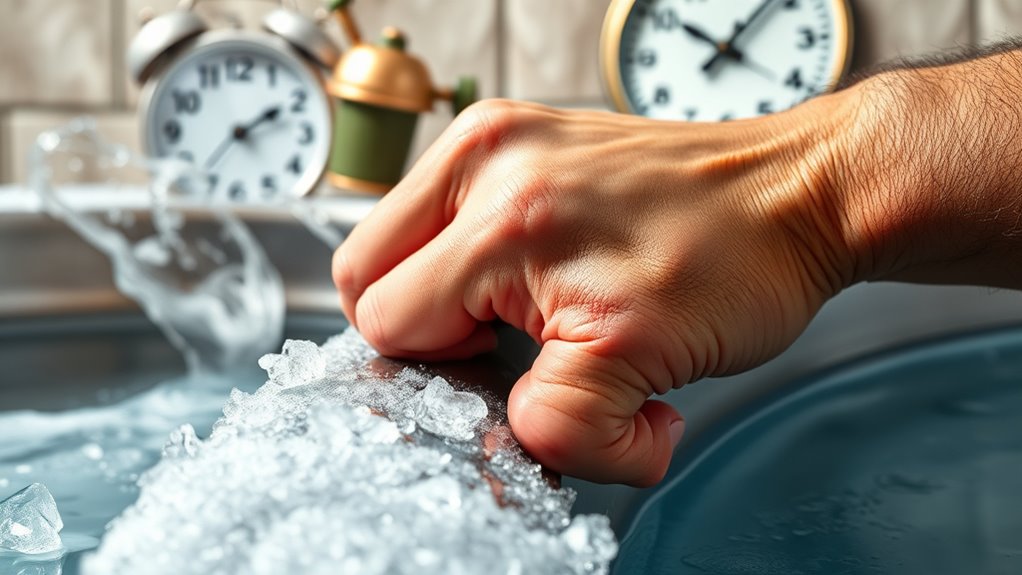
While it’s tempting to expect quick results from cold exposure, progress often takes time and patience. You might hope for immediate benefits, but mental resilience develops gradually through consistent practice. Focusing solely on rapid change can lead to frustration or giving up early. Remember, environmental factors like ambient temperature and your body’s response influence your experience, so results vary. By maintaining a steady routine, you build a foundation for long-term adaptation. Patience reinforces your mental resilience, helping you push through discomfort and setbacks. Ignoring the importance of consistency means missing out on the subtle improvements that accumulate over time. Instead, focus on steady, regular exposure, trusting that your body will adapt naturally—results will come, but only if you give them time.
Frequently Asked Questions
Can Beginners Safely Start Cold Exposure Without Prior Medical Consultation?
You should definitely seek medical advice before starting cold exposure, especially if you have underlying health issues. While cold exposure can be beneficial, it’s vital to follow safety precautions to avoid hypothermia or shock. Don’t skip consulting a healthcare professional, as they can advise you on safe protocols tailored to your health. Prioritizing safety guarantees you enjoy the benefits without risking your well-being.
Is It Necessary to Invest in Special Equipment for Cold Exposure Routines?
No, you don’t need special clothing or fancy gadgets for cold exposure routines. Just wear what keeps you comfortable and allows for temperature control—like a simple swimsuit or workout gear. Overthinking equipment can distract from the experience. Focus on listening to your body and gradually increasing exposure, rather than investing in high-tech gear. Remember, sometimes the best cold exposure is just a brisk walk outside in your usual clothes.
How Do I Stay Motivated to Maintain Consistent Cold Exposure Practices?
To stay motivated, focus on mindset strategies like setting clear goals and celebrating small wins. Habit formation is key—schedule your cold exposure sessions at the same time each day to build consistency. Remind yourself of the benefits, like increased resilience and mood boost, to reinforce your commitment. Keep a journal to track progress, and stay patient—motivation grows as your habits become part of your routine.
Are There Specific Health Conditions That Contraindicate Cold Exposure?
Think you’re invincible? Think again. If you have certain medical restrictions like cardiovascular issues, Raynaud’s phenomenon, or cold allergies, cold exposure could turn into a health risk rather than a boost. Always consult your doctor before plunging into icy waters. Ignoring these health risks can worsen your condition or cause unexpected emergencies. Don’t gamble your health on icy daredevilry—know your limits and get professional advice first.
What Are Some Common Psychological Barriers to Beginning Cold Exposure?
You might face fear avoidance and mental barriers when starting cold exposure, making it hard to take the first step. You could worry about discomfort, feeling overwhelmed, or losing control. These psychological hurdles can cause you to avoid trying cold exposure altogether. To overcome them, focus on gradual exposure, deep breathing, and reminding yourself of the benefits. Building confidence step-by-step helps you push past mental barriers and embrace cold exposure safely.
Conclusion
Think of cold exposure as tending a delicate garden. Rushing in with extreme cold, neglecting signs of overexposure, or expecting instant blooms can harm your progress. Instead, nurture it patiently, gradually increasing your resilience, listening to your body, and cultivating consistency. With time and care, you’ll find your garden of well-being flourishing—strong, vibrant, and resilient—just like a gardener who respects nature’s rhythm. Patience and mindfulness will reward you far more than hasty leaps.
